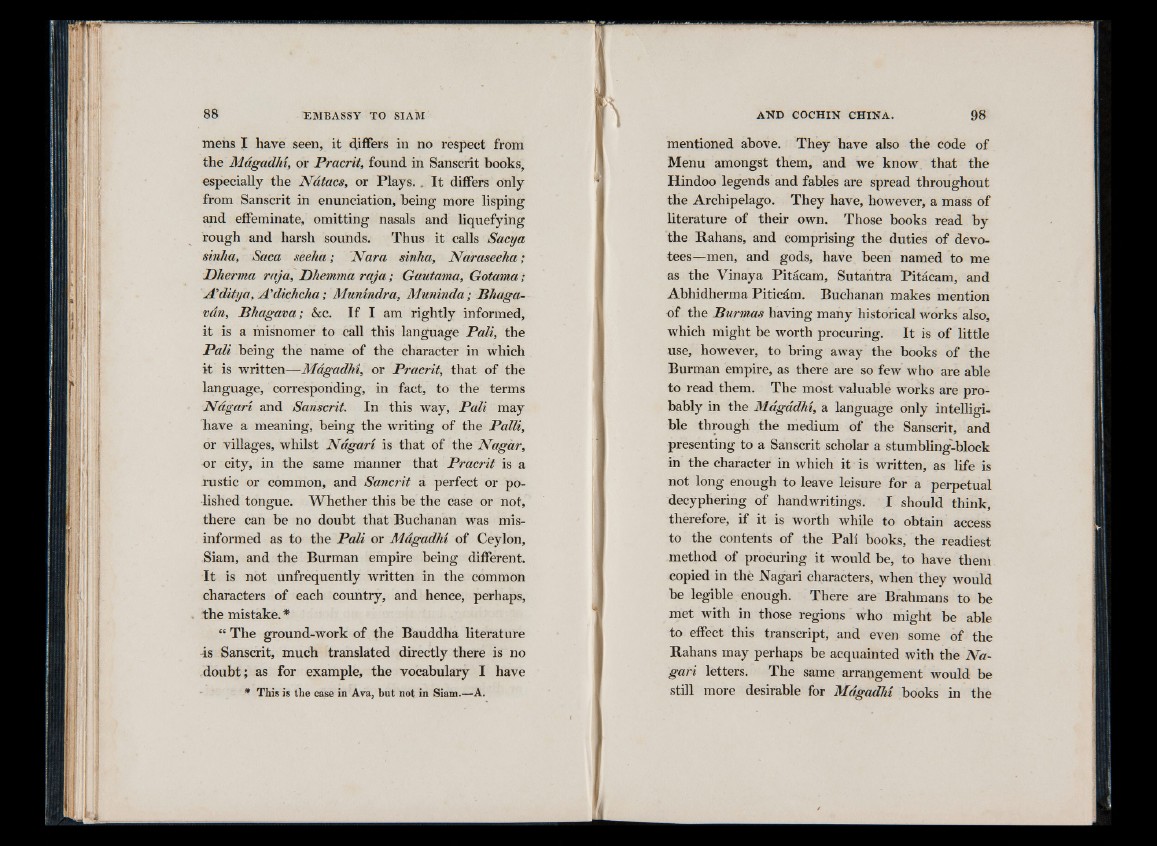
mens I have seen, it differs in no respect from
the Magadhi, or Pracrit, found in Sanscrit books,
especially the Natacs, or Play s.. I t differs only
from Sanscrit in enunciation, being more lisping
and effeminate, omitting nasals and liquefying
rough and harsh sounds. Thus it calls Sacya
sinka, Saca seeha; 'Nara sinha, Naraseeha;
Dherma raja, Dhemma raja; Gautama, Gotama;
A ’ditya, A'dichcha; Munindra, Muninda; Bhaga-
van, Bhagava; &c. If I am rightly informed,
it is a misnomer to call this language Pali, the
Pali being the name of the character in which
it is written—Magadhi, or Pracrit, that of the
language, corresponding, in fact, to the terms
Nagari and Sanscrit. In this way, Pali may
have a meaning, being the writing of the Patti,
or villages, whilst Nagari is that of the Nagar,
n r city, in the same manner that Pracrit is a
rustic or common, and Sancrit a perfect or polished
tongue. Whether this be the case or not,
there can be no doubt that Buchanan was misinformed
as to the Pali or Magadhi of Ceylon,
Siam, and the Burman empire being different.
I t is not unfrequently written in the common
characters of each country, and hence, perhaps,
th e mistake.*
“ The ground-work of the Bauddha literature
4s Sanscrit, much translated directly there is no
doubt; as for example, the vocabulary I have
* This is the case in Ava, but not in Siam.—A.
mentioned above. They have also the code of
Menu amongst them, and we know, that the
Hindoo legends and fables are spread throughout
the Archipelago. They have, however, a mass of
literature of their own. Those books read by
the Rahans, and comprising the duties of devotees—
men, and gods, have been named to me
as the Vinaya Pitacam, Sutantra Pitacam, and
Abhidherma Piticàm. Buchanan makes mention
o f the Burmas having many historical works also,
which might be worth procuring. It is of little
use, however, to bring away the books of the
Burman empire, as there are so few who are able
to read them. The most valuable works are probably
in the Magadhi, a language only intelligible
through the medium of the Sanscrit, and
presenting to a Sanscrit scholar a stumbling-block
in the character in which it is written, as life is
not long enough to leave leisure for a perpetual
decyphering of handwritings. I should think,
therefore, if it is worth while to obtain access
to the contents of the Pali books, the readiest
method of procuring it would be, to have them
copied in thè Nagari characters, when they would
be legible enough. There are Brahmans to be
met with in those regions who might be able
to effect this transcript, and even some of the
Rahans may perhaps be acquainted with the N a gari
letters. The same arrangement would be
still more desirable for Magadhi books in the